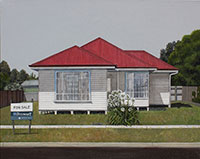
A sense of quietude pervades Robyn Sweaney’s new body of work. The mood is one of introspection and stasis. She explains that her current paintings were created amidst ‘a year of uncertainty and the complexities of a world where our collective experience of multiple lockdowns, orders to ‘stay at home’ and be ‘alone together’ have become the new normal’. The exhibition’s title, Long Road Home, references memories of pre-2020 excursions from Mullumbimby to visit family and the Victorian landscapes of childhood, as well as a 2012 residency in Broken Hill. ‘The vistas and dwellings I had encountered along the way were quite literally, a long way from home!’ remarks Sweaney. ‘More than just reflections on my travels, the imagery embodies the larger issues we’ve all faced. It is about distance, but also love, longing and hope.’
Sweaney is nationally recognised for her depiction of the modest houses that were constructed during an era of post-war optimism. The facades may have been unremarkable but having one’s very own plot of land augmented the prevailing sense of liberation. Multiple decades have since elapsed. ‘A home can symbolise many things. They can represent security and safety but that illusion can be tenuous,’ says Sweaney. ‘The simple houses I have painted are frozen in time and float in empty space like a mirage on multiple horizon lines, unsure of what is going to happen next,’ she imparts. ‘Collectively, they are a part of our history, a reminder of time passing, that things both good and bad are not going to last. These suburban houses are an ever-evolving backdrop to our lives.’
The new works sensitively document a way of life now in flux. They represent an endeavour to know what lies behind the appearance and transience of the things we see and experience. Sweaney describes her imagery as a combination of an expression of place infused with philosophical and poetic connotations. ‘My intention is to reach beyond visual appearances. Generally, what I am searching for is something that generates an emotional response.’
‘Not architecturally significant and often humble, they nevertheless reflect a distinctive aesthetic,’ continues Sweaney. With this in mind, her paintings are thoughtfully constructed with meticulous attention to detail, colour interactions and compositional factors. A curious glow emanates from the flat perfection of the acrylic on canvas surfaces and the geometric purity of sharply focused shapes. Sweaney discloses that she has unified the works in the exhibition by investing each house with small areas of reddish-hued detailing.
Heightening an aura of uncertainty, soft grey expanses rise above houses that are so non-descript they occasion not even a cursory glance from passers-by. Sweaney tells that although the front of the house is open to the street, its inner world is hidden behind layers of protection. Closed doors, security screens, low awnings, darkened windows, drawn curtains and blinds denote barriers to what lies beyond the garden fences. Letterboxes, power lines and television aerials are the only indication of a connection to the outside world.
The painting, Small Town Dreams, has a somewhat different ambience. A red triangular roof asserts visual presence but the house’s one-time occupants have gone. Standing in somewhat bedraggled, weed-sprouting grass is a prominent ‘For Sale’ sign. The absence of a power cable and letterbox serves to confirm the abandonment of residence and, as the title suggests, perhaps a dream.
The exhibition also includes still life works from Sweaney’s ongoing Heartland series. Collecting vintage ceramic ware and gathering bunches of flowers during solitary walks has always been a source of pleasure for her. She describes Australian natives in bloom as communicating ‘such a vibrancy and joyful abundance’. Multi-coloured native birds and fluttering insects hasten to their bounty. ‘The beauty and blossoms are so fleeting yet so life affirming,’ she muses. ‘Painting these still life subjects is grounding and calming. It connects me to the land and nature, which at times, can seem far removed during months of isolation in the studio.’
Metaphorically, the long road home can signify life’s journey – retracing memories of days long past, an embracing of the present and thence, a contemplation of what might lie ahead. ‘Under current circumstances, we do find ourselves looking into an unknown future,’ Sweaney muses. ‘Ordinary mundane moments and activities within one’s house and environment take on new meaning. There is a positivity in acknowledging the preciousness of the things we have and appreciating the intricate beauty of that which surrounds us.’ In conclusion she states, ‘I respectfully acknowledge the traditional owners of the land on which the houses I have drawn and painted stand’.
Receive e-mail updates on our exhibitions, events and more
Subscribe Now